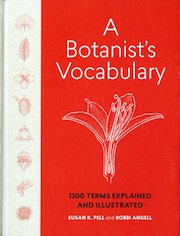A Botanist’s Vocabulary
Last Updated on November 21, 2022 by

by Susan K. Pell and Bobbi Angell
ISBN 978-1-60469-563-2
Timber Press, Inc., Portland, Oregon, 2016
Already in possession of a number of books defining botanical terms, I initially wasn’t particularly interested in looking at this book. I should have been, though, as I have long admired Bobbi Angell’s skill in botanical illustration. One look inside the cover and I was ready to toss the other books in favor of this newcomer. I hesitate to repeat the cliché, the one about how many words a picture is worth, so suffice it to say that if you can more quickly grasp the meaning of a word from a drawing than from additional words, consider adding this tome to your home library.
The authors are Susan K. Pell, Ph.D., Science and Public Programs Manager at the United States Botanic Garden in Washington, D.C., and Bobbi Angell, scientific illustrator for the New York Botanical Garden. The pooling of their talents has resulted in a book that is fun to browse even if you aren’t looking for a particular definition. Layout of the pages is not crowded, with plenty of space between the entries, making it aesthetically pleasing. The entries are arranged in two columns with the botanical term in red and the definition in black under it, sometimes followed by a synonym, antonym or another related term. The terms defined are a mixture of esoteric botanical jargon (cladoptosic, ocrea, pachycaul) and everyday words (bolt, boot, mouth). The latter gave Angell the opportunity to share an elegant drawing of the side view of a Penstemon flower.
The book consists of three sections. First, an introduction in which the authors explain that they chose terms used by botanists, naturalists and gardeners with the goal of simplifying and clarifying as much as possible. The body of the book is a glossary of 1300 terms, in alphabetical order from a- and abaxial to zygomorphic, including 726 line drawings. The final section of the book is a short section of recommended reading.
The terms are not limited to morphology, but include vocabulary from physiology and ecology. The authors chose words that “apply to a particular group of plants, such as orchids, grasses or irises.” From the perspective of agrostology, they defined important terms like awn, aristate, callus, collar, ligule, rachilla, and even showed us the difference between acute and acuminate. There is only one omitted that I miss: the difference between intravaginal and extravaginal branching in grasses, along with illustrations. If you’ve ever struggled through the Poa key in the Flora of North America, you understand. Robert Soreng even uses the term pseudointravaginal.
While the layout is pleasing and the definitions are clear and simple, what makes this book special are the lovely line drawings. Who might want this book? Everyone who enjoys botanical line drawings for their own beauty as well as their contribution to understanding the world of plants around us.
—Cindy Roché, High Desert Chapter.
